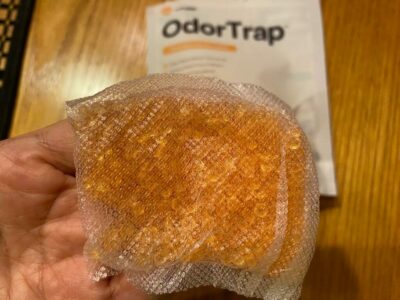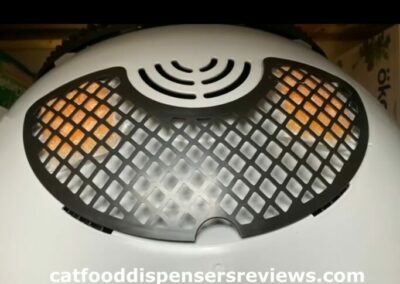
The Litter-Robot 4 does a very good job keeping the waste drawer sealed so odors don’t leak outside the litter box. But keeping a week’s worth of cat waste in a drawer inevitably causes odors inside of it. To help with this, the Litter Robot 4 includes a carbon filter. In addition, you can purchase the OdorTrap pack which is one of the many optional Litter Robot 4 accessories. The question is, which one works the best? How to use them? I have tested the carbon filter and the OdorTrap separately as a single-system approach, as well as both in tandem. It’s worth noting that achieving the best odor control also relies on using a top-performing cat litter for the Litter Robot.
My experience using carbon filters with the Litter Robot
I’ve been using the carbon filter with my Litter Robot 3 Connect for years, and it worked quite well. However, with the Litter Robot 4, the results have significantly improved, thanks to the strategic placement of the carbon filter right above the cat’s waste. The clever positioning ensures that as odors naturally rise, they are captured 100% by the carbon filter. In contrast, with the Litter Robot 3, the filter’s location on the waste drawer’s front vents didn’t fully trap all the emanating odors, allowing some to escape into the globe and cause a bit of a smell (cleaning the Litter- Robot 3 periodically is an important duty). In my video, you can see how the Litter Robot 4’s globe half-rotates when it’s time to replace the filter, exposing the filter compartment for easy access.
Globe rotates halfway exposing the bottom for easy filter replacement
Using OdorTrap Packs With My Litter Robot
I have used the OdorTrap pack in two different ways with my Litter Robot 4 because I was experimenting with the best setup to reduce odors optimally:
- First way: I placed two OdorTrap packs in the filter compartment of the Litter Robot. I didn’t use the carbon filter.
- Second way: I put the carbon filter in the Litter Robot’s filter compartment and placed the OdorTrap pack in the waste drawer, using the OdorTrap Pod (I reviewed the Pod in my Litter-Robot 4 accessories reviews).

How I installed the OdorTrap pack inside the Litter Robot 4’s waste drawer
I observed that when I placed the OdorTrap packs in the filter compartment, the odor control wasn’t quite as effective as with the carbon filter, but it still did a good job. Interestingly, putting the OdorTrap pack inside the waste drawer made a noticeable difference in the odors emanating from the drawer when I opened it to empty it. I went from thinking, ‘Yuck, this is not nice’ to ‘I can handle this smell until I tie the bag.’ The difference was quite refreshing!
Carbon Filter vs OdorTrap for the Litter Robot 4: Which Works Better?
In my experience, both prove to be highly effective in eliminating odors, but their distinct mechanisms for tackling bacteria-causing odors suggest an ideal setup. I recommend using the carbon filter in the filter compartment and the OdorTrap in the waste drawer of the Litter Robot 4. Employing both in tandem ensures the most efficient odor elimination for your Litter-Robot 4 (it works for me!). If you prefer a single-system approach, my suggestion is to opt for the carbon filter and complement it by sprinkling baking soda inside the waste drawer.
How to Use the Carbon Filter or OdorTrap in the Filter Compartment
Some people are confused and think they can place both the carbon filter and the OdorTrap packs in the filter compartment, but this is not feasible due to size constraints – it’s either one or the other. As I said, I found the carbon filter to work better in the filter compartment, while the OdorTrap pack excels in the waste drawer. I did further research on this topic to support the effectiveness of this specific setup and why it worked so well for me.
The Science Behind Carbon Filter vs OdorTrap in Litter-Robot Odor Control
How the carbon filter and the OdorTrap work to eliminate or reduce the bacteria-causing odors in the Litter Robot.
How Carbon filter works in eliminating odors in the Litter Robot
The Carbon Filter is crafted using activated charcoal, renowned for its exceptional ability to trap odors. Bad odors, categorized as ‘volatile organic compounds’ (VOC), pose health risks. But how does the carbon filter effectively eliminate them? The secret lies in the highly porous surface of the carbon filter, making it extraordinary in trapping a substantial quantity of volatile particles in the air. Henry Nowicki, Ph.D. and MBA, President and Senior scientist for PACS Activated Carbon Services, wrote in his article The Basics of Activated Charcoal Adsorption “A teaspoon of activated carbon has more surface area than a football field”. The carbon filter’s great molecular surface enables it to effectively trap and collect significant amounts of airborne volatile particles causing bad odors, a capability that lasts for up to a month in the case of the Litter Robot.
The Odor Adsorption Capacity of Carbon Filter
Some people have even tested at home the effectiveness of the carbon filter adsorption. Chua Cheng Yao, an expert who specializes in air quality and purity, shows in his article “Does Activated Carbon Filters Really Work?” the results of his experiment using a carbon filter to eliminate cigarette smoke vs not using it. The results showed that after a little less than 2 minutes the odor of cigarette smoke started to drop dramatically by using a carbon filter vs not using any. See the results of this experiment on SmartAirFilters.com.
How the OdorTrap Works in Eliminating Odors
The OdorTrap harnesses the power of plant-based oils with unique properties that enable them to attract, attach to, and envelop bad odor molecules. Through this distinctive mechanism, a chemical reaction occurs between the plant-based oils and the volatile organic compounds (bad odors), effectively eliminating the unpleasant smells.
The Odor-Reducing Capacity of Plant-Based Oils
In a study published by Frontiers in Environmental Science, a blend of coconut, lemon, and tea tree essential oils was sprayed on a window, resulting in a significant reduction of odor concentration. After spraying the mixture, the ammonia concentration decreased from 10,000 to 7,000 ug/m3, and the total odor concentration dropped from 23,757 ug/m3 to 13,056 ug/m3. Check this study on frontiersin.org.
My Thoughts on Odor Control as a Long-Term Litter Robot Owner
According to my experience, both the carbon filter and the OdorTrap proved to be highly effective in minimizing odors with the Litter Robot 4. However, the key to achieving optimal results lies in the strategic placement of each. The carbon filter, situated on the outer bottom of the Litter-Robot 4’s globe, sitting right above the cat waste, adeptly captures odors emanating from the waste drawer. In contrast, the OdorTrap pack excels at attracting, trapping, and enveloping the residual odors within the waste drawer. That’s my take after using both, hope it helps you with deciding.
To never run out of filters or OdorTrap packs subscribe and save 20% off the first month, plus free shipping. If you subscribe to 2 or more items you can save 25%. They will send you filters or OdorTrap packs to your door, every month, or every 2 or 3 months, plus, you can cancel the subscription or skip a delivery anytime.

Apply 20% Off your subscription today!
Leave a Reply